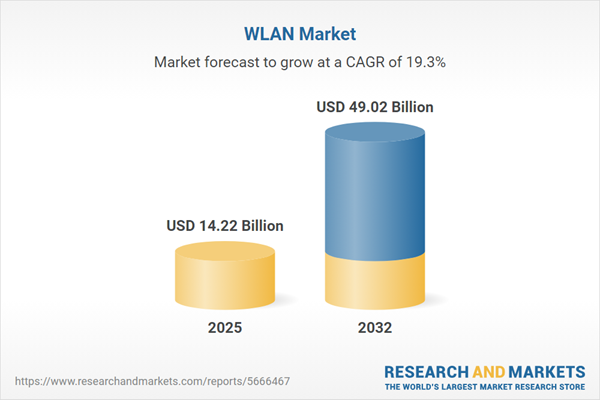Speak directly to the analyst to clarify any post sales queries you may have.
Wireless LAN technology is increasingly fundamental to modern enterprise strategies, enabling organizations to support evolving work models, secure their data environments, and streamline operations with reliable wireless connectivity. As businesses adjust to dynamic digital demands, robust wireless LAN infrastructure plays a central role in sustaining business agility and operational resilience.
Market Snapshot: Wireless LAN Market Size and Growth
In 2024, the global wireless LAN market reached USD 11.91 billion. This market is projected to expand to USD 14.22 billion in 2025 and USD 49.02 billion by 2032, reflecting a compound annual growth rate of 19.34%. Growth is primarily supported by enterprise investments in advanced LAN infrastructure aimed at boosting dependability and scalability. Organizations are modernizing their connectivity frameworks, adapting to hybrid working models, and integrating advanced collaborative technologies. These actions are elevating wireless connectivity to a strategic priority for IT leaders shaping enterprise networks.
Scope & Segmentation in the Wireless LAN Market
- Component: Solutions span network access points, antennas, controllers, and switches. These systems contribute to building scalable, secure infrastructure, while associated services such as consulting, deployment, and proactive network management address shifting enterprise security and operational demands.
- Technology: Developments include adoption of Wi-Fi 4, Wi-Fi 5, and Wi-Fi 6E. Each generation supports higher device densities, increasingly complex applications, and enables future integration with Internet of Things environments. Enterprises now emphasize technology selection based on scalability, coverage, and total lifecycle value.
- Deployment: Indoor and outdoor solutions drive connectivity for offices, hospitals, hospitality environments, and infrastructure hubs. These deployments help optimize workflows and maintain uninterrupted access to mission-critical applications and data.
- Frequency Band: Wireless LAN systems use 2.4 GHz, 5 GHz, and 6 GHz bands, equipping businesses to address varying levels of user density, manage data throughput, and ensure consistent signal reliability as demand increases.
- End User: Enterprises, public sector bodies, healthcare, hospitality, and residential sectors each introduce unique requirements for compliance, uptime, and data security. These needs shape infrastructure selection and deployment methods across verticals.
- Application: Wireless LAN enables a wide spectrum of uses including connecting business devices, integrating IoT endpoints, supporting surveillance systems, and powering unified communications. This accelerates collaboration and operational efficiency.
- Geographical Coverage: Adoption trends and regulatory priorities vary across the Americas, Europe, Middle East & Africa, and Asia-Pacific. Local dynamics affect implementation strategies, compliance standards, and technology adoption rates in each region.
- Leading Companies: Cisco Systems, Huawei Technologies, Hewlett Packard Enterprise, Ubiquiti, CommScope, NETGEAR, Juniper Networks, Extreme Networks, D-Link, and Cambium Networks deliver regionally and vertically tailored wireless LAN solutions that influence industry benchmarks for the sector.
Key Takeaways for Senior Decision-Makers
- Flexible wireless LAN deployment strategies enable organizations to support hybrid operations and swiftly adjust to new business models without disruption.
- Cloud-native and AI-enhanced network management are advancing automation, increasing network visibility, and optimizing resource allocation for diverse environments.
- Virtualization of network resources enhances scalability for Internet of Things rollouts and transforms performance analytics into actionable business intelligence for technology planning.
- Advanced security practices, including zero-trust protocols and real-time oversight, protect enterprise assets as network perimeters expand in distributed environments.
- Regulatory compliance strategies that anticipate policy changes promote longer system lifecycles and foster adaptability across multiple operational markets.
- Sustainability and cost control are optimized by deploying energy-efficient infrastructure and applying comprehensive lifecycle management for long-term organizational resilience.
Tariff Impact: United States 2025 Tariffs on WLAN Supply Chains
- Enterprises are diversifying supplier networks and considering nearshoring to minimize supply chain exposure to the impending 2025 U.S. tariffs on wireless LAN products.
- Procurement teams are realigning contracts and revising inventory approaches to avoid project delays and lessen risk from regulatory uncertainties.
- Vendors are introducing flexible pricing models and service packages, supporting enterprises in maintaining steady network investment during regulatory changes.
- Strong risk management practices and proactive supply chain oversight are becoming essential to preserve competitiveness in the rapidly changing market environment.
Methodology & Data Sources in Wireless LAN Market Research
This report leverages interviews with IT executives, network architects, and leading technology vendors, complemented by regulatory analysis and quantitative benchmarks. Special emphasis is placed on the impact of tariffs to provide enterprises with clear technological and strategic guidance.
Why This Report Matters for Enterprise Connectivity
- Wireless LAN strategies can be aligned with digital transformation and compliance objectives, ensuring infrastructure investments deliver adaptable and secure operational environments.
- Senior leaders gain critical perspective on evolving technology landscapes, shifts in procurement strategies, and regulatory changes to guide effective resource allocation and contingency planning.
- The report offers a framework to optimize vendor selection and network rollout, equipping IT teams to navigate risk and prioritize high-impact technology investments.
Conclusion
Wireless LAN is central to future-proofing enterprise connectivity. Informed with a detailed market view, leaders are well-prepared to design flexible, robust networks for evolving operational requirements worldwide.
Additional Product Information:
- Purchase of this report includes 1 year online access with quarterly updates.
- This report can be updated on request. Please contact our Customer Experience team using the Ask a Question widget on our website.
Table of Contents
3. Executive Summary
4. Market Overview
7. Cumulative Impact of Artificial Intelligence 2025
Companies Mentioned
The companies profiled in this WLAN market report include:- Cisco Systems, Inc.
- Huawei Technologies Co., Ltd.
- Hewlett Packard Enterprise Company
- Ubiquiti Inc.
- CommScope Holding Company, Inc.
- NETGEAR, Inc.
- Juniper Networks, Inc.
- Extreme Networks, Inc.
- D-Link Corporation
- Cambium Networks, Inc.
Table Information
| Report Attribute | Details |
|---|---|
| No. of Pages | 194 |
| Published | November 2025 |
| Forecast Period | 2025 - 2032 |
| Estimated Market Value ( USD | $ 14.22 Billion |
| Forecasted Market Value ( USD | $ 49.02 Billion |
| Compound Annual Growth Rate | 19.3% |
| Regions Covered | Global |
| No. of Companies Mentioned | 11 |









